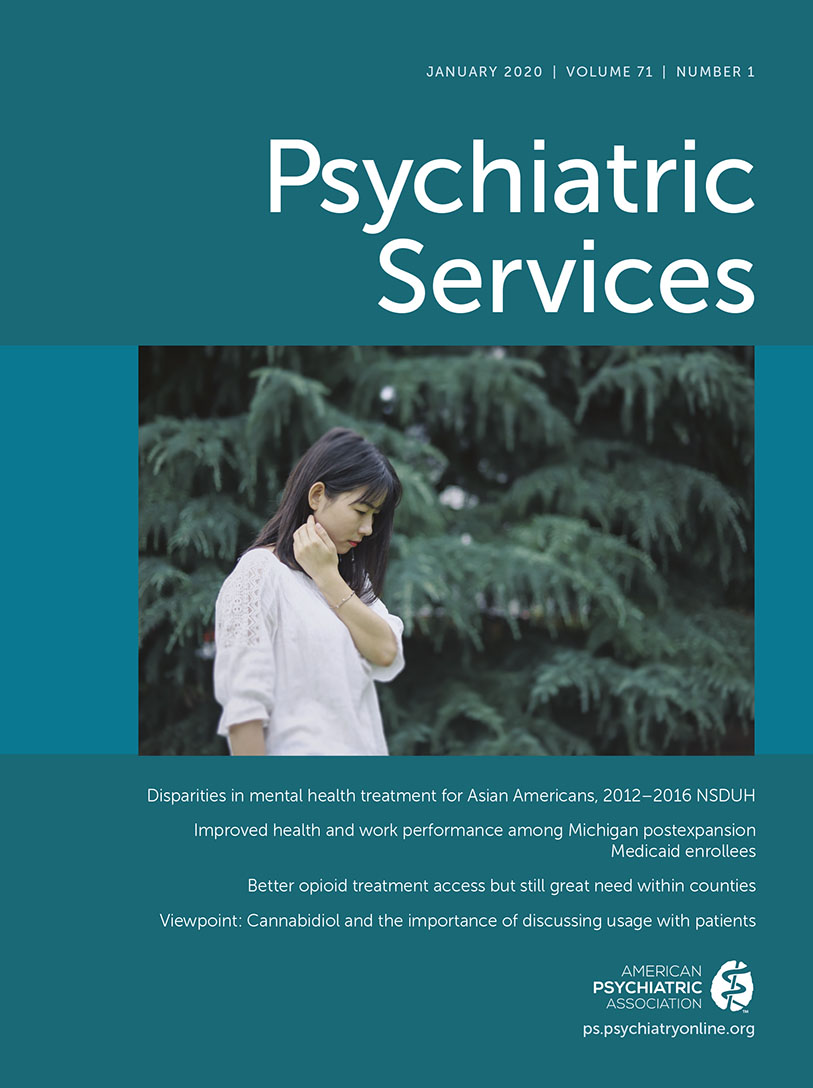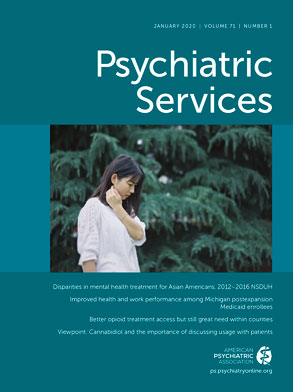Social determinants of health, of which poverty is a significant example, can contribute to poor health outcomes as well as to increased risk for developing a mental illness (
1). Poverty is complex and multidimensional and is discussed in the literature as being connected to overall health, psychiatric symptoms, self-efficacy, and general quality of life (
2). Poverty can become a vicious cycle that traps individuals, ensnares families in generational poverty, and contributes to historically impoverished communities over many years. Persistent poverty is a particularly salient challenge facing individuals with serious mental illnesses, who are more likely than the general population to experience poverty, unemployment, and low salaries and are at a higher risk of homelessness and involvement in the criminal justice system (
3). These experiences are compounded by settings that propagate other negative social determinants—including discrimination, food insecurity, and limited access to health care (
4)—that further perpetuate a poverty trap among individuals and communities.
Individuals experiencing poverty are relegated to living in inadequate built environments—the human-made, physical aspects of the places where people live and work. These environments restrict opportunities to exit poverty for people using behavioral health services, leaving them trapped in circumstances that increase stress, exacerbate symptoms of many mental illnesses, contribute to risks of addiction, and compromise general medical health. In fact, living in neighborhoods with inadequate built environments is associated with an increased likelihood of depression (
5), which is connected to increased risk for cardiovascular events. Furthermore, in low-income communities, inadequate housing is prevalent, and studies indicate associations between poor housing and both mental health and substance use conditions (
6). Both the built and social environments of urban areas can contribute to isolation. People residing in socially isolated communities often have difficulties managing crises and experience the onset of mental health conditions; furthermore, higher risks of mental health concerns and premature mortality are associated with a lack of social networks (
6). The structures of the local neighborhoods and communities where individuals live in poverty are not designed to promote upward mobility, and this circumstance creates stress that can have a further negative impact on both mental health and overall health.
Living in poverty also contributes to general lack of well-being through undesirable consequences across the eight dimensions of wellness (
7). Most clearly, financial wellness, which involves the possession of financial resources to meet practical needs and a sense of control and knowledge about personal finances (
7), is negatively affected when individuals live in poverty and lack a sense of control over their financial status. Poverty and lack of economic opportunity also have emotional consequences, such as low self-esteem, low self-efficacy, self-stigma, and feelings of hopelessness, depression, and anxiety. Limited access to medical and dental care can thwart the use of preventive and lifesaving services, thereby affecting an individual’s overall health. In addition, medical supplies such as glasses, hearing aids, and medications can be too expensive for individuals experiencing poverty or can be inaccessible as a result of the inadequate built environment in communities where low-income populations reside. These environments also may prevent safe physical activity, like walking. This situation is directly connected with environmental wellness, in that areas with high crime, substandard housing, and lack of green spaces can prevent outdoor physical activity and contribute to a sense of feeling demoralized. This circumstance has consequences for spiritual wellness, because individuals living with low incomes in these environments may experience a sense of purposelessness. Furthermore, intellectual wellness can be affected by a lack of available educational opportunities or a lack of accessibility because of costs associated with acquiring further education. Occupational consequences result when individuals with a serious mental illness and/or other behavioral health conditions experience periods of underemployment or unemployment; the latter creates a gap in a resume that is unappealing to employers. Finally, poverty can influence social wellness and may lead to social isolation if any individual lacks affordable transportation or sustains decreased social networks resulting from lack of employment, volunteer, or educational opportunities. Although not exhaustive, these examples illustrate the constellation of life experiences and areas of well-being affected by living in poverty and highlight the importance of expanding behavioral health system programming to bring financial skills training to individuals who use behavioral health services. Supporting the rise out of poverty will have positive consequences that affect the whole person, whole communities, and future generations.
Longstanding norms in behavioral health services can be changed, improved, and redesigned to become antipoverty practices. Although some behavioral health services agencies have included financial education for the people they serve, this effort is likely insufficient for overcoming poverty. Services also need to address financial literacy—the knowledge and skills needed to find, evaluate, understand, and use information to manage personal funds and financial products. Financial literacy has the potential to improve access, skills, abilities, and connection across various dimensions of wellness and well-being, promoting positive health outcomes while helping to combat the vicious cycle of poverty.
Similarly, the focus of services provided to individuals with serious mental illnesses generally should be broadened from money management to financial wellness, which can be examined with multiple indicators. Objective indicators of financial wellness may include measures such as income, debt, credit rating, and savings, as well as aspects of financial capability, such as knowledge of credit terms, financial products and services, financial planning, and budgeting. Subjective indicators of financial wellness may include financial self-efficacy, a sense of control, satisfaction with one’s current financial situation, and hope for the future, including a belief in one’s ability to reach personal financial wellness goals (
8). Transforming existing practices to move beyond financial education to include programs and services that promote financial literacy and financial wellness has the potential to improve financial self-sufficiency and independence among individuals with behavioral health conditions. People who live with a mental illness, a substance use disorder, or co-occurring disorders have the right to participate in the economic marketplace like other citizens (
9) and to make decisions, including financial decisions, that affect their own lives. This right is an issue of social justice that remains largely unaddressed in current behavioral health services.
Many individuals with mental illnesses are encouraged to apply for supplemental income programs to increase cash flow for basic needs—a factor that contributes to the cyclical poverty experienced by individuals in this population. It is not uncommon for individuals with disabilities related to mental health conditions to receive Supplemental Security Income or Social Security Disability Insurance. These benefits may, in some instances, allow an individual to meet basic needs, but they will not provide an individual with the resources necessary to attain financial self-sufficiency. These benefits may address “absolute poverty”—having inadequate income to meet basic needs—but do not sufficiently eliminate relative poverty, where limited resources restrict the ability to share the same living standards, inclusion, and access as others. One study found that 95% of individuals with a serious mental illness (N=114) did not believe they had the funds to meet their needs through the next month (
10). Supplemental income programs do not effectively support sustaining and growing finances.
Employment is one avenue to acquire the funds to meet basic needs, yet the safety net of government benefits often proves to be a disincentive to work. Many programs rely on evidence-based supported employment to facilitate a return to, or entry into, the workplace. Although this approach may help with securing work, including competitive and regular employment, it is not inherently beneficial for asset building and poverty reduction. These services and supports, without proper efforts to promote financial literacy and financial wellness, may fail to help individuals with serious mental illnesses and other behavioral health conditions improve their financial status and participate in their own economic outcomes.
Various additional strategies can be used, based on a holistic, social-ecological approach to addressing the issue of poverty among individuals with serious mental illnesses and other behavioral health conditions. On an individual level, behavioral health providers can provide training on financial literacy and financial wellness to increase knowledge and skills (e.g., “Building Financial Wellness,” developed by P. Nemec, M. Swarbrick, J. Cook, et al., 2019). Behavioral health service agencies can establish savings programs and incentives for employees and for the people they serve (
9) as one way of demonstrating the value of financial wellness. These programs give individuals the opportunity to contribute to their own savings while developing and using financial knowledge and skills.
On an interpersonal level, helping to build strong social networks, identifying financial predators in a person’s life, and offering peer support around financial wellness can assist with reducing risk and enhancing economic opportunity. Financial wellness coaching can provide education, guidance, practical skills, application procedures, and peer support around financial wellness and money management.
Efforts to foster safety and resiliency on the community level can include outreach to the places people work, learn, and play in order to convene conversations about poverty and create strategies for improving social norms in the community. On the community level, agreements with local financial institutions, services, and supports can be made to create a referral network for helping individuals with mental illnesses or co-occurring disorders receive financial counseling and credit advice, establish bank accounts, and build their credit.
On a societal or policy level, behavioral health services, along with their community partners, can seek to transform public policy to improve social determinants in low-income communities. Advocacy may be needed to maintain existing policies that provide financial advantages to people living in poverty, such as the earned income tax credit and Social Security work incentive programs. Conversations with community members can drive a plan to address negative social determinants and adverse community experiences, further changing social norms by backing those changes with policy, such as mental health parity legislation or the creation of a task force to address social determinants. Advocating for improved features of the built environment, such as safe, walkable sidewalks that community members can use to walk to work or to local transit, or educating policy makers on the relationship among mental illnesses, substance use, and poverty may help lay the groundwork for improving outcomes and creating the structures necessary to end the cycle of poverty among individuals with serious mental illnesses.
This list is not exhaustive. Instead, it is illustrative of sample strategies with a social-ecological approach that behavioral health service agencies can take—alone or in collaboration with key stakeholders, including community leaders and individuals with lived experience with poverty and mental health conditions—to combat poverty, improve financial security, and promote asset building for individuals with mental illnesses. By viewing poverty as a social-ecological problem, financial wellness can be considered a social justice issue, an elevated designation that may clarify that poverty is an issue of collective concern and not the responsibility solely of individuals experiencing it. Poverty is a significant social determinant of health, and behavioral health service agencies can engage in prevention efforts and support individuals who have behavioral health conditions in building financial literacy and financial wellness skills in order to improve their socioeconomic conditions.
The authors urge service providers, agency administrators, funders, and policy makers invested in prevention, intervention, and treatment for mental illnesses and substance use disorders to recognize that an added focus on financial wellness can benefit people with mental illnesses. Behavioral health service agencies have an important role in educating the people they serve and the people they employ about the importance of financial literacy and financial wellness. Behavioral health services need to help promote the development of money management skills; offer encouragement, tools, resources, and peer support for developing goals and plans for financial wellness; and help individuals access financial services and asset development programs. Although expanding and refocusing services is not necessarily quick or easy to achieve, doing so will make financial wellness more accessible for people with mental illnesses who live in poverty. As the saying goes, “A hand up is better than a handout”—behavioral health services would do well to remember that.

